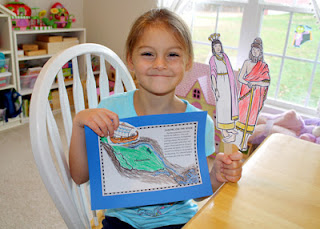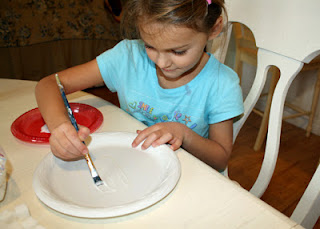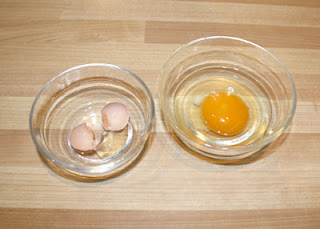 |
| All set for Halloween! Tessa and Kanani as ancient cave dwellers. |
Tuesday, October 30, 2012
Halloween Sneak Peek
Remember me saying that Tessa REALLY enjoyed studying about ancient cave dwellers? Well, here's a sneak peek of the Halloween costume I sewed up for her to wear tomorrow night. She insisted that her American Girl doll have one too!
Labels:
Ancient History,
Everything Else


Picture Word Puzzles - Challenge Cards
These cute little Trend Picture Word Puzzles - Challenge Cards were hiding out in one of our homeschool supplies totes. I decided to put them into action before Tessa totally outgrows them. Yeah, they're pretty easy for her now, but she's enjoying them and they serve as a nice little warm-up right before her reading lesson each day.
 |
| Trend Picture Word Puzzles cards are a fun way to warm up right before settling in for a reading lesson. The cards are double-sided and feature phonetic rhyming text. |
Labels:
Everything Else,
Reading


Friday, October 26, 2012
Life Science - Week 5
Bodies Grow & Change
We have officially kicked off our study of the human body. I haven't counted up the weeks, but we'll be hanging out here for a while...at least a couple of months. Should be fun! Tessa started wanting to learn more about the inner workings of the body at the end of summer. I'm so glad we're finally here. I felt guilty constantly putting her off, saying that we would study it very soon.
Wednesday
Friday
Other Books of Interest
We have officially kicked off our study of the human body. I haven't counted up the weeks, but we'll be hanging out here for a while...at least a couple of months. Should be fun! Tessa started wanting to learn more about the inner workings of the body at the end of summer. I'm so glad we're finally here. I felt guilty constantly putting her off, saying that we would study it very soon.
Wednesday
- Read I'm Growing! by Aliki.
- Completed Evan-Moor ScienceWorks for Kids: How Your Body Works, Grades 1-3 "Bodies Change as They Grow Older - How Have We Changed?" and "A Book About Me" activities (pages 6-7) from TeacherFileBox.com.
 |
| Tessa created an accordion book that highlights how she has grown and changed over the years. |
Friday
- Watched Bill Nye the Science Guy: Life Cycles DVD by Disney.
- Read Scholastic Discover More: See Me Grow by Penny Arlon.
- Read The Growing-Up Tree by Vera Rosenberry.
- Completed Evan-Moor ScienceWorks for Kids: How Your Body Works, Grades 1-3 "Bodies Change as They Grow Older - Human Life Cycles" and "Other Life Cycles" activities (page 8, minus growth-record booklet) from TeacherFileBox.com.
Other Books of Interest
- The Growing Story - Ruth Krauss
- Growing Like Me - Anne Rockwell
Ancient History, Week 5
Sumerian Crafts & Kings
We finished up our survey of the first civilization of Sumer by learning more about Sumerian daily life, their crafts, trade, and King Sargon of Akkad.
Wednesday
Thursday
Friday
We finished up our survey of the first civilization of Sumer by learning more about Sumerian daily life, their crafts, trade, and King Sargon of Akkad.
Wednesday
- Looked up and defined HO dictionary word for Lesson 3, Main Lesson Part 2.
- Read Usborne: Ancient World by Fiona Chandler (pages 8-9).
- Completed corresponding Blue House School ancient world worksheets.
- Listened to Tales from the Arabian Nights audiobook (story of Sheherezade) by Andrew Lang/Tavia Gilbert.
Thursday
- Completed "Ancient Mesopotamia" history pocket (puppets, and interactive map with model ship).
- Read You Wouldn't Want to Be a Sumerian Slave! by Jacqueline Morley.
- Watched Ancient Civilizations for Children: Ancient Mesopotamia DVD by Schlessinger Media.
- Listened to Tales from the Arabian Nights audiobook (story of Aladdin and the Wonderful Lamp) by Andrew Lang/Tavia Gilbert.
Friday
- Read Evan-Moor Read and Understand Literature Genres: Myths & Legends, Grades 4-6 "Gilgamesh and Enkidu - Middle Eastern Legend" story sheet from TeacherFileBox.com.
- Completed "Long Robe" from Ancient Egyptians and Their Neighbors: An Activity Guide by Marian Broida.
- Listened to Tales from the Arabian Nights audiobook (story of Ali Baba and the Forty Thieves) by Andrew Lang/Tavia Gilbert.
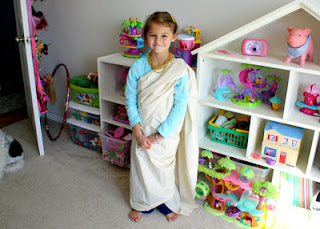 |
| Tessa in our version of a Mesopotamian long robe. |
* HO = History Odyssey, SOTW = The Story of the World
Looking for more Sumerian lesson ideas?
Check out my Label a Sumerian Chariot Diagram and Standard of Ur Writing Paper & Toppers digital curriculum helpers!
Looking for more Sumerian lesson ideas?
Check out my Label a Sumerian Chariot Diagram and Standard of Ur Writing Paper & Toppers digital curriculum helpers!
Friday, October 19, 2012
Life Science, Week 4
Plant Cells vs. Animal Cells
We finished up our brief study of cells this week by determining the differences between plant cells and animal cells. Tessa also learned the name and function of select cell parts of each.
Friday
We finished up our brief study of cells this week by determining the differences between plant cells and animal cells. Tessa also learned the name and function of select cell parts of each.
Friday
- Completed RSO Cell Lab 2: Plant and Animal Cells Differ.
- Watched "Cells" music video by They Might Be Giants via YouTube.
- Watched The Magic School Bus: Goes Cellular by Scholastic via YouTube.
I'm not much of a music buff, so my discovery of the band They Might Be Giants is probably way old news for most people. I came across one of their videos entitled, "Cells" while searching YouTube last night. I played it for Tessa today. She absolutely loved it! We watched it at least ten times. (Remember, if you have cruddy internet access like me, use SaveVid to download YouTube videos to your hard drive, then play them without interruption later.)
Other Resources of Interest
* RSO = R.E.A.L. Science Odyssey
Fruit and Gelatin Cell Models
Cell Lab 2: Plants and Animal Cells Differ is a great little hands-on lab. It requires just a few simple ingredients besides basic household supplies...gelatin, green grapes, an orange (or strawberry) and toothpicks. Since the gelatin is to be softly set, I prepared it and sliced the fruit the morning of the lesson.
Other Resources of Interest
- "Animal and Plant Cells" free printable diagram from Education.com.
- Evan-Moor ScienceWorks for Kids, Grades 4-6+: The Human Body "Cells Are the Fundamental Unit of Life" unit (just the animal and plant cell diagram) from TeacherFileBox.com.
* RSO = R.E.A.L. Science Odyssey
Fruit and Gelatin Cell Models
Cell Lab 2: Plants and Animal Cells Differ is a great little hands-on lab. It requires just a few simple ingredients besides basic household supplies...gelatin, green grapes, an orange (or strawberry) and toothpicks. Since the gelatin is to be softly set, I prepared it and sliced the fruit the morning of the lesson.
 |
| Tessa pushed orange slices and grapes into lemon-flavored gelatin. The oranges represented nuclei and the grapes stood in as chloroplasts (for the plant cell). |
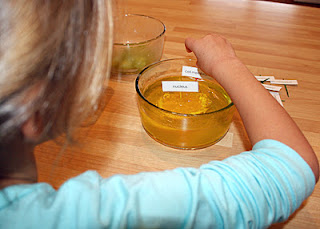 |
| Tessa labeled the parts of her fruit and gelatin cell models. |
Wednesday, October 17, 2012
Ancient History, Week 4
First Civilization
History Odyssey Lesson 3 focuses on Mesopotamia, the first civilization of Sumer, cuneiform writing and ancient temples called ziggurats. Since the number of activities for Part 1 and Part 2 seemed a bit lopsided, I decided to divide the workload a little more evenly. What isn't listed below, we will complete next week. I also felt like the recommended ziggurat project was a bit much for us, so we went with a much quicker and simpler one.
Monday
Tuesday
Other Books of Interest
* HO = History Odyssey
Quick and Sweet Ziggurat
Looking for more Mesopotamia lesson ideas?
Check out my Label a Sumerian Chariot Diagram and Standard of Ur Writing Paper & Toppers digital curriculum helpers!
History Odyssey Lesson 3 focuses on Mesopotamia, the first civilization of Sumer, cuneiform writing and ancient temples called ziggurats. Since the number of activities for Part 1 and Part 2 seemed a bit lopsided, I decided to divide the workload a little more evenly. What isn't listed below, we will complete next week. I also felt like the recommended ziggurat project was a bit much for us, so we went with a much quicker and simpler one.
Monday
- Looked up and defined HO dictionary word for Lesson 3, Main Lesson Part 1, word number one.
- Read Usborne: Ancient World by Fiona Chandler (pages 6-7).
- Completed corresponding Blue House School ancient world worksheets.
- Completed HO map work for Lesson 3, Main Lesson Part 1.
- Read The Golden Sandal: A Middle Eastern Cinderella Story by Rebecca Hickox.
Tuesday
- Looked up and defined HO dictionary word for Lesson 3, Main Lesson Part 1, word number two.
- Completed "Ancient Mesopotamia" history pocket (student booklet, words to know, and ziggurat pop-up book).
- Read A True Book: Mesopotamia by Sunita Apte.
 |
| The pop-up ziggurat book was Tessa's favorite part of the "Ancient Mesopotamia" history pocket. This activity required precision folding, cutting and gluing, all of which were challenging for her. |
 |
| Tessa's completed pop-up ziggurat book! How cool is that?! |
Wednesday
- Completed "Quick and Sweet Ziggurat" from Ancient Egyptians and Their Neighbors: An Activity Guide by Marian Broida.
Other Books of Interest
- City of Rainbows: A Tale from Ancient Sumer - Karen Pollinger Foster
- History Opens Windows: The Sumerians - Jane Shuter
* HO = History Odyssey
Quick and Sweet Ziggurat
History Odyssey lists "Model Ziggurat" from Ancient Egyptians and Their Neighbors: An Activity Guide by Marian Broida as this week's recommended project. While I think it's a worthy project, it requires way too much prep work, skill and drying time for Tessa's age set. Maybe we'll try it during our second cycle of ancients when Tessa is a middle schooler. Instead, we completed "Quick and Sweet Ziggurat", which is listed as an alternative project at the end of "Model Ziggurat". Most supplies for "Quick and Sweet Ziggurat" can easily be found around the house. We only had to buy a $1.50 box of sugar cubes from Wal-Mart.
 |
| Tessa created a rectangle with rows of six cubes, four cubes deep. She stacked the rest of the cubes pyramid style to the top. |
 |
| Sugar cubes cut into halves made perfect stairs. |
 |
| Tessa's sugar cube ziggurat. Quick and sweet for sure! |
Looking for more Mesopotamia lesson ideas?
Check out my Label a Sumerian Chariot Diagram and Standard of Ur Writing Paper & Toppers digital curriculum helpers!
Labels:
Ancient History,
History Odyssey


Monday, October 15, 2012
Teach Them Spanish! - Grade K
Who knew finding good Spanish curriculum for the younger grades would prove to be so difficult? After a lot of digging, I unearthed maybe six-to-nine options. Most felt very homegrown. Several were rather pricey...for no apparent reason. All lacked in some way. I finally decided on Teach Them Spanish!, Grade K by Instructional Fair, an imprint of Carson-Dellosa.
The following plans are how I chose to divide and supplement the lessons in Teach Them Spanish!, Grade K. Most books and videos listed are not included in the curriculum. While I am confident Tessa could memorize the Spanish words and their English equivalents in this curriculum in a much shorter amount of time than noted, that isn't my goal. I want her to develop a true familiarity with them. Tessa officially studies Spanish twice a week, but I try to incorporate appropriate Spanish words and phrases into daily life as well.
Although I studied Spanish for five years during high school and college, I am far from fluent. With a lot preparation, I could probably teach Tessa using the language immersion approach during Spanish time. However, I highly doubt that would be a pleasant experience for either of us. So, I speak to her in both English and Spanish. I do a lot of code switching. I also supplement with Spanish language immersion videos, audio/video clips of native speakers, picture books...anything I can find that's of decent quality.
Teach Them Spanish!, Grade K is full of potential. It provides lesson plans, worksheets, classroom activities, games, songs and reading lists. However, the curriculum, which consists of one inexpensive 96-page black-and-white reproducible paperback book could be much better designed. Lessons need to be better defined and organized. They require a lot of flipping back-and-forth within the book as it is. On a positive note, the content is age-appropriate, fun and requires little-to-no writing. Tessa is enjoying it.
 |
The following plans are how I chose to divide and supplement the lessons in Teach Them Spanish!, Grade K. Most books and videos listed are not included in the curriculum. While I am confident Tessa could memorize the Spanish words and their English equivalents in this curriculum in a much shorter amount of time than noted, that isn't my goal. I want her to develop a true familiarity with them. Tessa officially studies Spanish twice a week, but I try to incorporate appropriate Spanish words and phrases into daily life as well.
Note: Teach Them Spanish!, Grade K would be easiest to use with regular access to a copy machine. However, the book could be taken apart (it's staple bound) and be used that way. After Teach Them Spanish!, Grade K, we will likely use newly released School Song Spanish by Classical Academic Press.
---------------
These plans are a work in progress. I will add to them (and delete, when necessary) as Tessa and I progress through the curriculum.
For each lesson, I either use Forvo to download MP3 files of native speakers speaking corresponding words or search Usborne Quicklinks for the same thing. I transfer the files to my Kindle Fire and play them for Tessa several times.
Day 1
These plans are a work in progress. I will add to them (and delete, when necessary) as Tessa and I progress through the curriculum.
For each lesson, I either use Forvo to download MP3 files of native speakers speaking corresponding words or search Usborne Quicklinks for the same thing. I transfer the files to my Kindle Fire and play them for Tessa several times.
Day 1
Say Hola to Spanish - Susan
Middleton Elya
Introductions and
Greetings - Teach (7)
"Hola Means
Hello" - Song (48)
Usborne: First Picture Spanish Interactive - Play appropriate phrases from "En La Escuela" and "En La Fiesta" segments.
Pictures of Greetings
- Worksheet (8)
Global Wonders: Mexico DVD - Global
Wonders
Day 2
Say Hola to Spanish, Otra Vez - Susan Middleton Elya
Introductions and
Greetings Poster - Review (79-80)
"Adios Means
Goodbye" - Song (48)
Usborne: First Picture Spanish Interactive - Play appropriate phrases from "En la Escuela" and "En la Fiesta" segments.
Greetings Paste-Up -
Worksheet (9)
Day 3
Numbers Introduction
1-5 - Teach (10)
Usborne: First Sticker Book: Easy Spanish Words - Play Quicklinks sound files for numbers 1-5.
"Cinco
Amigos" - Song (48)
Classroom Counting -
Activity (54)
Numbers Review -
Worksheet (11)
Little Pim: I Can Count DVD (Episodes 1-2) - Little Pim Co.
Day 4
Numbers Poster -
Review 1-5 (81-82)
Usborne: First Sticker Book: Easy Spanish Words - Play Quicklinks sound files for numbers 1-5.
Roll 'Em - Activity
(54)
Matching Numbers -
Worksheet (12)
Little Pim: I Can Count DVD (Episodes 3-4) - Little Pim Co.
Day 5
Numbers Poster -
Review 1-5 (81-82)
Usborne: First Sticker Book: Easy Spanish Words - Play Quicklinks sound files for numbers 1-5.
Dominoes - Activity
(54)
Number the Shoes -
Worksheet (13)
Day 6
Colors Introduction - Teach (14)
Colores de la Vida - Cynthia Weill
Find Classroom Colors
- Activity (55)
Find the Crayons -
Activity (55)
Pictures to Color - Worksheet
(15)
Little Pim: Playtime DVD (Episode 1) - Little Pim Co.
Day 7
Colors Poster - Review
(83-84)
My First Book of Spanish Words - Katy R. Kudela - Find the named colors. (24-25)
McGraw-Hill's Spanish Picture Dictionary - Find who's wearing the named colors. (74-75)
Rainbow Colors -
Worksheet (55)
Whistlefritz: Spanish for Kids, La Fiesta de Fritz DVD - Whistlefritz
Day 8
Colors Poster - Review
(83-84)
El Artista Que Pinto Un Caballo Azul - Eric Carle - Read by native speaker via YouTube.
I Spy - Activity (55)
Color the Cars -
Worksheet (17)
Day 9
Numbers Poster -
Review 1-5, Teach 6-10 (81-82)
"Diez
Amigos" - Song (49)
Uno, Dos, Tres: One, Two, Three - Pat Mora
Classroom Counting -
Activity (56), or use McGraw-Hill's Spanish Picture Dictionary (28-29).
1-10 Matching -
Worksheet (18)
Little Pim: I Can Count DVD (Episodes 5-7) - Little Pim Co.
Day 10
Numbers Poster -
Review 1-10 (81-82)
Counting Ovejas - Sarah Weeks
Beanbag Counting -
Activity (56), or count toys, beans, counters, etc.
Count the Cookies -
Worksheet (19)
Day 11
Numbers Poster -
Review 1-10 (81-82)
Roll 'Em - Activity
(56)
Critters 1-10 -
Worksheet (20)
Whistlefritz: Spanish for Kids, Vamos a Jugar DVD - Whistlefritz
Day 12
Numbers Poster -
Review 1-10 (81-82)
Count on Culebra: Go from 1 to 10 in Spanish - Ann Whitford Paul
My Favorite Number -
Worksheet (21)
Numbers Paper Chain -
Activity (56, 69)
Day 13
"Colors
Song" - Song (49)
Find It! - Activity
(57)
Birds of Color - Worksheet (22)
Birds of Color - Worksheet (22)
Day 14
Colors Poster - Review
(83-84)
Find the Crayons -
Activity from Colors, Part 1 (55)
Casa de Colores -
Worksheet (23)
Day 15
Colors Poster - Review
(83-84)
Colors Bingo -
Activity (57), or use cards from a store-bought Spanish bingo game.
Flores y Colores -
Worksheet (42)
Day 16
Colors Poster - Review
(83-84)
I Spy - Activity (57),
or use McGraw-Hill's Spanish Picture Dictionary (54-55).
De Colores - Worksheet
(25)
Day 17
Read Books of Choice
My Name is Gabito - Monica Brown
My Name is Gabriela - Monica Brown
Cuckoo: A Mexican Folktale - Lois Ehlert
Elena's Serenade - Campbell Geeslin
Off We Go to Mexico - Laurie Krebs
Dear Primo: A Letter to My Cousin - Duncan Tonatiuh
Diego - Jonah Winter
Frida - Jonah Winter
Day 18
Watch Video of Choice
Spanish for Kids: Learn Spanish for Beginners Level 1, Volume 1 DVD - Language Tree
The Three Caballeros DVD - Walt Disney Studios Home Entertainment
Day 19
Classroom Things -
Teach (26)
"Classroom
Objects Song" - Song (49)
Label the Classroom - Activity (58)
Matching Objects -
Worksheet (27)
Day 20
Classroom Objects
Poster - Review (85-86)
Scavenger Hunt - Activity (58), modified for home-school environment.
Draw and Color Your
Classroom - Worksheet (28)
Day 21
Classroom Objects
Poster - Review (85-86)
McGraw-Hill's Spanish Picture Dictionary - Find the named classroom object. (28-29)
McGraw-Hill's Spanish Picture Dictionary - Find the named classroom object. (28-29)
Match Pictures and
Words - Worksheet (29)
Day 22
Family Words - Teach
(30)
"Family
Song" - Song (50)
Draw Your Family -
Worksheet (31)
Day 23
The Family Poster -
Review (87-88)
My First Book of Spanish Words - Katy R. Kudela - Find the named family members. (4-5)
McGraw-Hill's Spanish Picture Dictionary - Find the named family member. Then, count how many girls
and boys. (7-8)
Family Word Meanings -
Worksheet (32)
Day 24
The Family Poster -
Review (87-88)
Guess Who? - Activity
(59)
Matching Family -
Worksheet (33)
Day 25
Food and Drink - Teach
(34)
"Food Song"
- Song (51)
My Meal - Worksheet
(35)
Little Pim: Eating and Drinking DVD (Episodes 1-4) - Little Pim Co.
Day 26
Food Poster - Review
(90)
Food Practice -
Activity (60)
Food Meanings -
Worksheet (36)
Day 27
Food Poster - Review
(90)
Mixed-Up Food -
Worksheet (37)
Day 28
Clothing - Teach (38)
"Clothing
Song" - Song (50)
My First Book of Spanish Words - Katy R. Kudela - Find the named clothing item. (8-9)
Clothing Match-Ups -
Worksheet (39)
Whistlefritz: Spanish for Kids, Vamos a Jugar DVD - Whistlefritz
Day 29
Clothing Poster -
Review (91-92)
Who's Wearing...?/What
Color...? - Activity (61), or use McGraw-Hill's Spanish Picture Dictionary (34-35).
How Are You? - Worksheet
(40)
Day 30
Clothing Poster -
Review (91-92)
Find the Clothing -
Activity (61), modified for home-school environment.
Clothes to Color -
Worksheet (41)
Day 31
Places to Go - Teach
(42)
"Community
Song" - Song (51)
Picture This! -
Worksheet (43)
Day 32
Community Poster -
Review (93-94)
Book Scavenger Hunt -
Activity (62), modified for home-school environment.
My Neighborhood -
Worksheet (44)
Day 33
Community Poster -
Review (93-94)
Guess What? - Activity
(62)
Places, Please -
Worksheet (45)
Day 34
Dot-to-Dot - Worksheet
(46)
Read Books of Choice
My Name is Gabito - Monica Brown
My Name is Gabriela - Monica Brown
Day 35
Watch Video of Choice
Spanish for Kids: Learn Spanish for Beginners Level 1, Volume 1 DVD - Language Tree
The Three Caballeros DVD - Walt Disney Studios Home Entertainment
Labels:
Teach Them Spanish


Saturday, October 13, 2012
Life Science, Week 3
Cells
We're gearing up for a lengthy study of the human body. This week, Tessa learned about cells by taking a look at a rather large example that can be seen without a microscope!
Thursday
Friday
We're gearing up for a lengthy study of the human body. This week, Tessa learned about cells by taking a look at a rather large example that can be seen without a microscope!
Thursday
- Watched Bill Nye the Science Guy: Cells DVD by Disney.
Friday
- Read Greg's Microscope by Millicent E. Selsam.
- Completed RSO Cell Lab #1: An Egg is a Cell.
This was a great quick and easy lab that provided some basic hands-on knowledge of one special type of cell. Next week, we'll dip our toes a little deeper.
 |
| Tessa inspected the tiny holes of an egg shell. These holes allow air and water in and out of the cell. |
 |
| After comparing her lab diagram to a real egg, Tessa labeled and colored its parts. |
* RSO = R.E.A.L. Science Odyssey
Subscribe to:
Posts (Atom)


